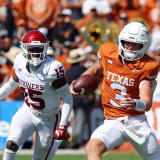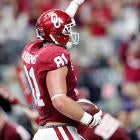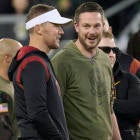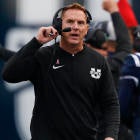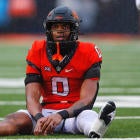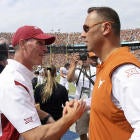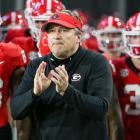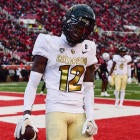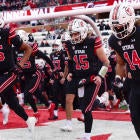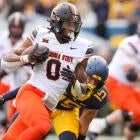Gil Brandt threw the full weight of his 84 years of life, draft and NFL knowledge at Oklahoma tight end Mark Andrews this week.
"I told him not to come out, stay in school, [that] he'd be a third-round choice," said Brandt, the longtime NFL personnel guru. "He came out. He'll be a third-round choice. He'd be a lot better off because there's a weak class next year. He'd have a chance to move up."
As a redshirt junior, Andrews was a consensus All-American and Mackey Award winner (best tight end) who was Heisman winner Baker Mayfield's favorite target. Those honors matter only a little compared to the harsh realities of NFL Draft evaluation. Andrews is one of what is expected to be a record 112 underclassmen betting their skills matter enough to get them drafted in the first two rounds, where the real money is.
(That 112 figure is the current total of underclassmen that have declared for the draft as posted by NFL.com. The NFL is expected to release the official list later this week.)
The odds continue to mount against their success. Since 2014, when NFL draft evaluations changed for juniors, almost a third (31.6 percent) of those declaring have gone undrafted. Using that ratio, a record 37 underclassmen won't be drafted in April. The total reflects a growing trend of bad advice, rampant agent runners and simply bad choices by some players.
It's a trend that long ago got the attention of college and NFL types. The total number of undrafted underclassmen since 2014 (118) is roughly equal to the roster size of the average FBS program.
"Whether or not you want to believe it or not, there are a lot of people in these kids' ear," new Arizona coach Kevin Sumlin said. "There are even more people in their families' ear that really don't understand, financially, you can play your way into a lot more money."
Alabama coach Nick Saban has railed for years about the influence of agents -- both legitimate and sleazy.
"If a guy didn't get drafted in the first or second round, he should have kept his butt in school," Saban said last summer.
That comes from the coach who probably does the best job of advising his juniors on the NFL Draft.
"Nobody does it better than Nick Saban," Sumlin said. "Nobody."
When juniors go undrafted, "there is no other league to go develop in," Saban added. "If they don't make the team [as a free agent], there is nothing for the guy to do. That's bad for the league."
That's also bad for colleges, where football is the only major sport that fully serves as a de facto minor league for the pros. Basketball players can leave after a year. Country club athletes in tennis and golf can turn pro at anytime.
And let's not be naive. Coaches recruit to -- and athletes embrace -- a three-year exit strategy.
"I don't know if anything has really changed except the panic of being left out and not getting the money," said Rob Rang, a veteran talent evaluator for NFLDraftScout.com. "In today's world of social media and expectations, young players are more easily convinced to try to take advantage of their perceived draft value."
The NFL began accepting prospects three years out of high school 29 years ago. That league tenet has survived periodic legal challenges for three decades. All of it has created a micro-population of elite athletes with something less than a full grasp of the process.
"You can't help the length of your arms if you're an O-lineman," Sumlin said. "You can't help your height. The things mentally that you can help, instinctually, ball skills, change of direction, you can work on those things [if you stay]."
But coaches are hardly objective at times in these cases. It's in their best interest to keep their best players for as long as possible. The NFL is cold, cruel, exacting place.
Last year's list of 28 unclaimed juniors included the Big 12's leading pass catcher in Baylor's K.D. Cannon, Florida State leading receiver Travis Rudolph and one-time Miami 1,000-yard rusher Joe Yearby. Among Power Five conferences, the SEC had the most misses -- five.
Meanwhile, from 2013-15, 56 of the 63 players (89 percent) given a first- or second-round grade by the NFL were drafted in those rounds.
Brandt has been a key member of the influential NFL College Advisory Committee that provides the most accurate information.
"They keep coming every day [into the draft] and about 50 of them shouldn't come," Brandt said of the underclassmen. "They're getting the right information from the league, but they don't pay any attention to it."
Andrews most likely will get drafted somewhere. In fact, CBS Sports has him going at the end of the first round. But that's hardly the point. The 7-year-old NFL rookie salary cap makes the chase for that second deal more urgent.
Rookie contracts are limited to four years. First-round deals contain an option for a fifth year. There is no dollar limit to the second contract, highlighting the dilemma. That is, when to come out to best fit into the first round, which best maximizes the payout on that second contract.
Compare all that to the average career computed by the NFL Players Association -- 3.3 years.
Beginning in 2014, the NFL simplified the evaluation process. Prospects were given either a first-round grade, second-round grade or neither, which ostensibly is a recommendation to stay in school.
But even though that projection process has been refined, a record number of underclassmen have gone undrafted in the four years since it has been changed. It started in that watershed 2014 year with almost 40 percent of underclassmen (36 of 98) not being taken. In subsequent years, the miss rate has never sunk below 28.8 percent.
Almost 32 percent of underclassmen overall (118 of 373) have gone undrafted since 2014.
The Athlete Agents Act was adopted in 2000 to protect athletes from unscrupulous agents. The law has now been enacted in 41 states.
The NCAA sent out a directive in November updating football players on their draft options.
Oregon senior associate athletic director Jeff Hawkins has been a dogged defender of the purity of the draft process. He sent his own email to media scolding the NCAA for not acknowledging agent laws on the books in those states.
"Here they are mentioning all these things and they don't mention the law," Hawkins said. "The NCAA has a seat at the table. If you're not going to get in the boat, get out of the boat."
While questioning Andrews, Brandt went out of his way to compliment West Virginia's Dana Holgorsen. The Mountaineers coach was able to keep key underclassmen in the fold. Quarterback Will Grier and receiver David Sills (18 receiving touchdowns) are returning.
"Some of these players are kind of reading too much into their own hype," Rang said. "They're getting fed a line from some of the agents trying to make money off of these players. Family members and friends, as well. I'd like to think most of those players get the quality advice of going back to school. They're trying to strike while the iron is hot."
The downside: Cannon, that Baylor receiver, is on his fourth team as an undrafted free agent. Rudolph, that FSU receiver, shuttled between the New York Giants practice squad and active roster. Yearby hasn't yet signed an NFL contract.
The upside: Sometimes a Stanford degree trumps the NFL. It certainly did for the biggest winner of the junior sweepstakes. Running back Bryce Love announced his return this week for his senior season.
The nation's No. 2 rusher and Heisman frontrunner for 2018 is just as likely to be preparing for medical school as the 2019 draft.


